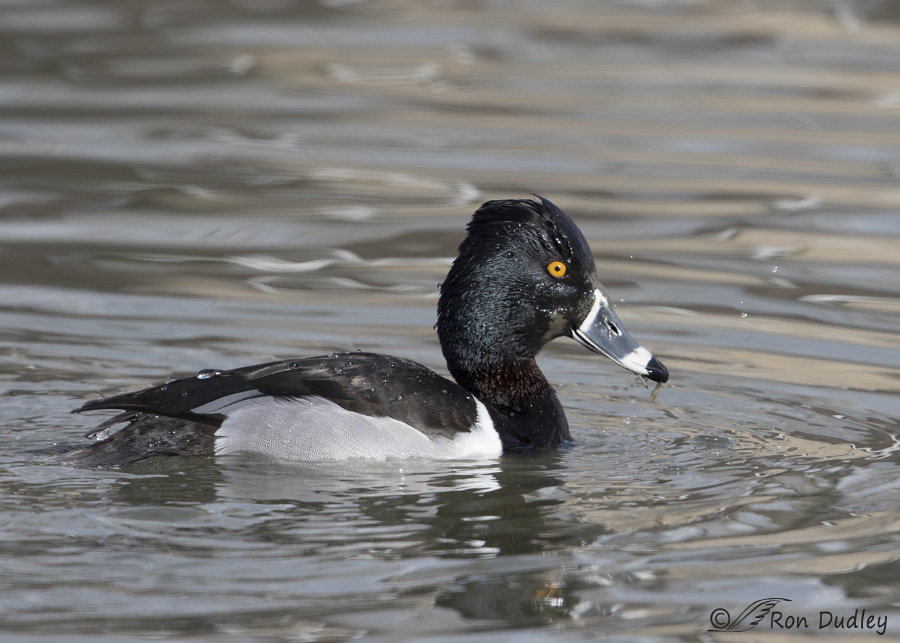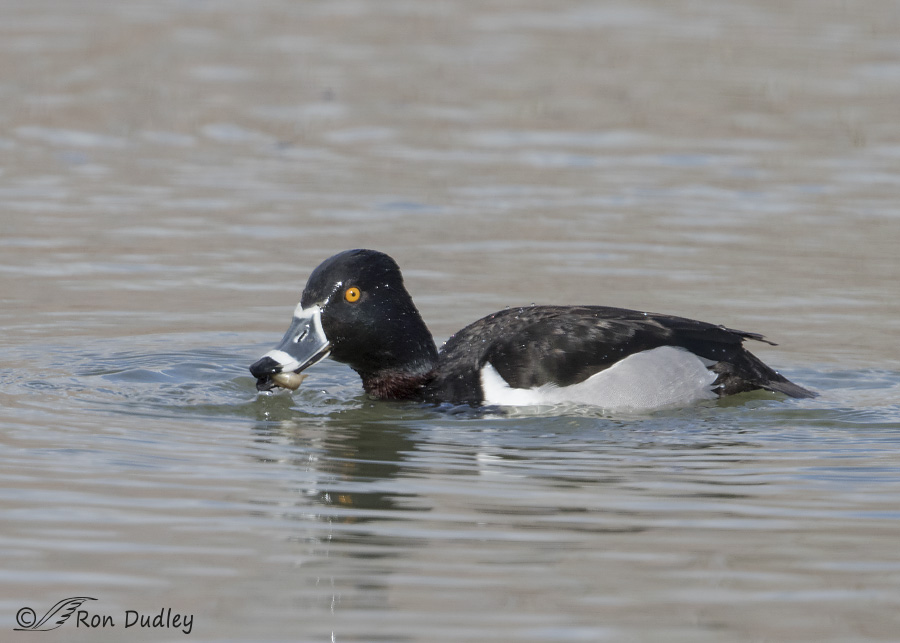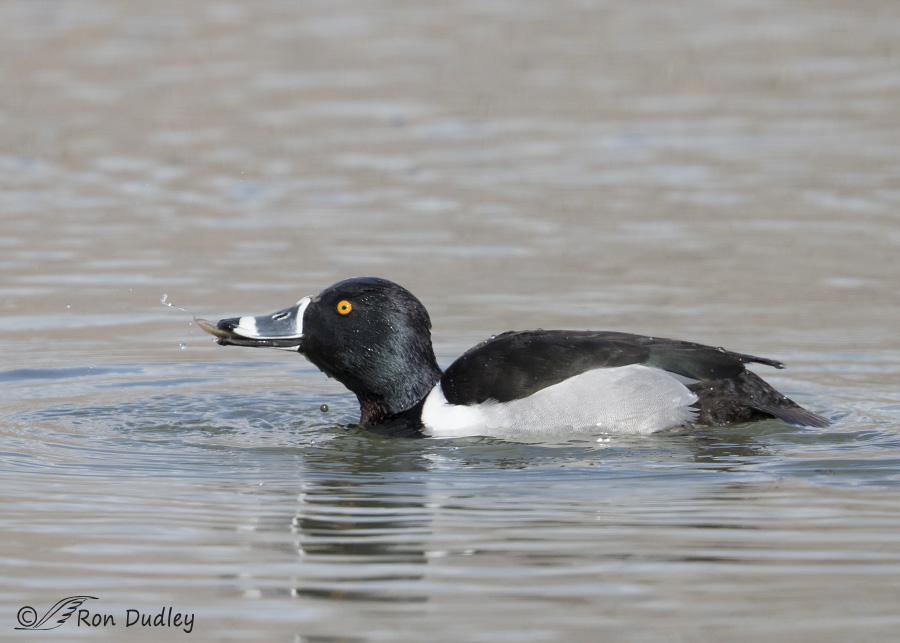As Margie Dunham pointed out in the first comment below I’ve misidentified this duck – it’s a Ring-necked Duck! I hate it when my stupid mistakes are on public display like this! Much of this post about the loach is still valid but obviously the part about diet specific to Lesser Scaups is not. However, the diet of Ring-necked Ducks (moist-soil and aquatic plant seeds, tubers and aquatic invertebrates) also excludes free swimming prey like fish so I’m still surprised to see this duck eating an apparent loach.
Not enough coffee this morning I guess. Sorry…
It seems that the invasive Weather Loach is becoming a significant food source for many of the birds in northern Utah. In recent years I’ve photographed Common Goldeneyes, Snowy Egrets, Greater Yellowlegs, Pied-billed Grebes and Belted Kingfishers eating them and several other species (coots and gulls) attempting to steal them from other birds. Yesterday I may have added another species to the growing list of loach-eaters.
It is assumed that the source of Weather Loaches (also known as Dojo Loaches, there are several species) in our waters is intentional release by aquarists when they no longer can/will care for their fish.

1/2000, f/6.3, ISO 500, Canon 7D Mark II, Canon EF 500mm f/4L IS II USM + 1.4 tc, not baited, set up or called in
This lone male Lesser Scaup has been hanging around a local pond for about a week now. I often photograph him while I’m waiting for an opportunity with the Belted Kingfisher I’ve posted recently but he doesn’t give me a lot of variety in behavior or poses because all he seems to do is repeatedly dive for food – all… day… long!
The diet of Lesser Scaups consists primarily of aquatic invertebrates (though seeds and aquatic plants can play a significant role in their diet in unusual circumstances). My research indicates that scaups rarely eat fish. The only examples I could find of fish-eating by scaups is opportunistic feeding when the fish have already been injured or killed.
Lesser Scaups typically swallow their invertebrate prey underwater so I could never see what this bird was eating. Until yesterday.

1/2000, f/6.3, ISO 500, Canon 7D Mark II, Canon EF 500mm f/4L IS II USM + 1.4 tc, not baited, set up or called in
It appears to me that this scaup was eating a Weather Loach. It’s remotely possible that it’s a large leech but I believe I can see a dorsal fin so I don’t think so. Though scaups usually swallow their food underwater they’re known to occasionally handle slightly larger prey on the surface.

1/2000, f/6.3, ISO 500, Canon 7D Mark II, Canon EF 500mm f/4L IS II USM + 1.4 tc, not baited, set up or called in
The probable loach went down quickly so this is the only other shot I was able to get of it.
Over the last few years I’ve become increasingly concerned by the obviously very high concentrations of loaches in our streams and ponds along the Wasatch Front. Yes, they’re providing a food source for many birds but at what cost? The environmental impact of invasive species is usually dire and typically very little is done about them until it’s too late.
When I first reported the presence of loaches at Farmington Bay WMA to the DNR fisheries folks several years ago they were unaware of their presence there, though they did know they were found in the Jordan River and possibly elsewhere. But they seemed relatively unconcerned about it and as far as I know (yes, I’ve searched) there’s been no significant investigative studies or research regarding their potential environmental impact. When I started photographing birds nine years ago most of the small fish I saw birds eating were young carp. Now they seem to be overwhelmingly loaches. Loaches are small bottom feeders so they usually escape our radar unless we pay attention to what a bird is eating (or actually do some species-focused field research…)
I hope this doesn’t turn out to be yet another example of too little, too late.
Ron
PS – For anyone interested in seeing additional examples of local birds I’ve photographed eating loaches simply type “weather loach” into the search box at the upper right hand corner of this page.
An unrelated note: I continue to get queries from readers asking if it’s ok to post links to my blog on social media and elsewhere (I think the warning I have printed in red on the right side of my blog has made ethical folks a little nervous about doing so). I have no problem with posting actual links to my blog – in fact I encourage it.
My issue is with folks who lift (copy) my images and then post them.


Not to make light of the invasive species issue, but maybe the loaches can crowd out some of the invasive carp.
I’ll take a ring -necked duck over one of those “lesser” ducks any day. Heck, I wouldn’t have known the difference if you hadn’t mentioned it. I’m now an expert on the two, having researched them this morning. Thank you!
You should consider selling prints of your photos. I’d buy one.
I do often sell them when asked, Angela. It’s just that I don’t advertise prints on my blog or website because selling prints is usually more work than the return is worth.
Sigh. So many of the invasive species are OUR fault. Deliberate or accidental introduction. The ‘pest’ species is doing what it can to survive.
And increasingly I am thinking that we are probably the most invasive and destructive species of them all. And putting ourselves on an undeserved pedestal claiming superiority.
“The ‘pest’ species is doing what it can to survive”
Exactly, EC – they cannot be rightfully blamed.
Re:”an unrelated note”: Does this mean I can’t have one of your images of a Weather Loach( or Dojo) tattooed on my forehead???
Only if you take a photo of it and allow me to post it on my blog, Patty!
Super shots and great news. At least the birds are doing their part to eliminate those loaches.
Charlotte
Thank you, Charlotte.
It’s not just a matter of the apparent increasing numbers of loaches, but, if the fish being eaten are so often loaches, is it because their numbers are crowding out other, native species and/ or they easier to catch, and if so, what kinds of controls are happening re: other species? This kind of stuff worries me….
I’m concerned about exactly the things you mention, Patty.
You have shown so many pictures of various birds eating loaches, that I can’t help but worry about them competing with and crowding out native species…and the subsequent results.. It seems that whenever this kind of replacemen of a native species by an introduced one happens, ithe results are seldom positive or desireable….another case of “here we go again “?
Into each life, stupid errors happen. Remember, from the critters’ perspective, we’re only human, a lesser species. I know how annoying that Perfectionist part of Self can be, but we all love you.
I know how annoying that Perfectionist part of Self can be, but we all love you.
Like everybody else, I abhor invasive species–starlings, for example, are hawk food in my world. However, they happen (stupid humans). If they turn into a food source for native species, they’ve reached a higher purpose. The question is, are enough species dining on enough of them to keep them in a reasonable population balance?
“from the critters’ perspective, we’re only human, a lesser species”
I’ve certainly reinforced that theory this morning, Laura!
Hi Ron,
Another plus to this post is that one can actually see the “ring” on the Ring-necked Duck! If one looks at the base of the neck, the first image depicts it very nicely, and there is a
hint of it in the second. Nice!
Cheers,
Dick
I agree Dick, that image is one of the few Ring-necked Duck shots I have where the ring is actually fairly visible.
No need to apologize. Mistakes happen.
What’s important here is your concern and alert about the invasive species. Yes I agree with you they can be very threatening to the environment.
I like ducks. They help me to improve my photographic skills.
I often use ducks for photo-practice too, Jorge. In fact lately, when I’ve been taking so many test shots with my lens to see if it was repaired correctly, I’ve taken more duck shots than I ever have before.
Don’t feel bad Ron, I have been birding for 68 years and I identified the back of a hawk which turned out to be a dead tree branch – didn’t realize it till I moved my position – man was my face red.
Great shots of a Ring-necked Duck!
Thanks for the support and encouragement, Dick.
To some of us a duck, is a duck, is a duck (pretty much)! Glad folks are more discerning tho.
Glad folks are more discerning tho.  Hope the loaches aren’t becoming a problem. Good shots, Ron! Obviously the lens is working as it should now.
Hope the loaches aren’t becoming a problem. Good shots, Ron! Obviously the lens is working as it should now.
Judy, I’m a lot happier with my lens than I am with my ID skills this morning…
Ron,
I think the duck in the above post is a ring necked duck, related to the lesser scaup. We just returned from a trip to areas north and west of Duluth and saw our first ring necked duck with that distinctive bill.
I’m enjoying your posts.
Regards,
Chris Brockmeyer
Chris, You and Margie are so right. I’m leaving in a few minutes to go out photographing birds and hide my head in the sand. I just hope this day ends quickly…
Believe you have a ring necked duck there!
Damn, I believe you’re right, Margie. Hate it when I make stupid errors like that. I’ll try to rescue this post as best I can…